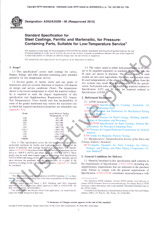We need your consent to use the individual data so that you can see information about your interests, among other things. Click "OK" to give your consent.
ASTM D7463-21
Standard Test Method for Adenosine Triphosphate (ATP) Content of Microorganisms in Fuel, Fuel/Water Mixtures, and Fuel Associated Water
Translate name
STANDARD published on 1.4.2021
The information about the standard:
Designation standards: ASTM D7463-21
Note: WITHDRAWN
Publication date standards: 1.4.2021
SKU: NS-1022189
The number of pages: 8
Approximate weight : 24 g (0.05 lbs)
Country: American technical standard
Category: Technical standards ASTM
The category - similar standards:
Annotation of standard text ASTM D7463-21 :
Keywords:
adenosine triphosphate, assay, ATP, ATP Bioluminescence Assay, bacteria, biocontamination, biodeterioration, biomass, capture solution, cellular, extracellular, fuel, fungi, hydrophilic particles, luciferin, luciferase, luminometer, microbe, microbiology, Relative Light Unit (RLU),, ICS Number Code 07.100.99 (Other standards related to microbiology),75.160.20 (Liquid fuels)
Additional information
| Significance and Use | ||||||||||||||||||
|
5.1?This test method measures the concentration of ATP present in the sample. ATP is a constituent of all living cells including bacteria and fungi. Consequently, the presence of ATP is a reliable indicator of microbial contamination in fuel systems. ATP is not associated with matter of non-biological origin. 5.2?This test method differs from Test Method D4012 as follows: 5.2.1?By providing for the rapid determination of ATP present in a fuel (petroleum) sample, a fuel and water mixture sample, fuel-associated bottom water sample, and extracellular ATP freely available in the fuel or aqueous sample matrix; 5.2.2?By providing for a method to capture, extract, and quantify ATP using self-contained test device and luminometer; 5.2.3?By providing a method of quantifying ATP present in fuel or water matrices in generally less than 10 min; and 5.2.4?By providing for the rapid separation of the ATP from chemical interferences that have previously prevented the use of ATP determinations in complex fluids containing hydrocarbons and other organic molecules. 5.3?This test method does not require the use of hazardous materials and does not generate biohazard waste. 5.4?This test method can be used to estimate viable microbial biomass, to evaluate the efficacy of antimicrobial pesticides, and to monitor microbial contamination in fuel storage and distribution systems. |
||||||||||||||||||
| 1. Scope | ||||||||||||||||||
|
1.1?This test method provides a protocol for capturing, concentrating, and testing the adenosine triphosphate (ATP) present in a fuel system sub-sample (that is, test specimen) associated with: 1.1.1?Microorganisms and hydrophilic particles found in liquid fuels as described in Table X6.1, or 1.1.2?Microorganisms and hydrophilic particles found in mixture of fuel and associated bottom water or just associated bottom water. 1.1.3?ATP detected by this bioluminescence test can be derived from cellular ATP, extra-cellular ATP, or some combination of both. 1.1.4?Cellular and extra-cellular ATP utilized to perform ATP bioluminescence are captured and concentrated from a fuel system sample into an aqueous test specimen (that is, sub-sample) for testing. For example, for a fuel system sample that does not contain any visible fuel associated bottom water, the aqueous test specimen is the capture solution itself described in 8.2.1.1. For fuel system samples that are a mixture of fuel and associated bottom water (that is, free water), the test specimen is an aliquant of the capture solution and associated bottom water. 1.2?The ATP is measured using a patented bioluminescence enzyme assay, whereby light is generated in amounts proportional to the concentration of ATP in the sample. The light is produced and measured quantitatively using dedicated ATP test pens2 and a dedicated luminometer2 and reported in (instrument specific) Relative Light Units. 1.3?This test method is equally suitable for use in the laboratory or field. 1.4?Although bioluminescence is a reliable and proven technology, this method does not differentiate ATP from bacteria or fungi. 1.5?For water or capture solution samples, the concentration range of ATP detectable by this test method is 1 ? 1011 M to 3 ? 108 M which is equivalent to 1 ? 1014 moles/mL to 3 ? 1011 moles/mL for water samples or capture solution. Assuming testing on fuel phase is performed on a 500 mL volume of fuel the equivalent concentrations is fuel would be: 6 ? 1011 M to 2 ? 1014 M. 1.6?The values stated in SI units are to be regarded as standard. No other units of measurement are included in this standard. 1.6.1?There is one exceptionRelative Light Unit (RLU) as defined in 3.1.19. 1.7?This standard does not purport to address all of the safety concerns, if any, associated with its use. It is the responsibility of the user of this standard to establish appropriate safety, health, and environmental practices and determine the applicability of regulatory limitations prior to use. 1.8?This international standard was developed in accordance with internationally recognized principles on standardization established in the Decision on Principles for the Development of International Standards, Guides and Recommendations issued by the World Trade Organization Technical Barriers to Trade (TBT) Committee. |
||||||||||||||||||
| 2. Referenced Documents | ||||||||||||||||||
|
We recommend:
Technical standards updating
Do you want to make sure you use only the valid technical standards?
We can offer you a solution which will provide you a monthly overview concerning the updating of standards which you use.
Would you like to know more? Look at this page.




 Cookies
Cookies
